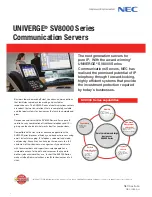
Disk Management
59
NAS 2000s Administration Guide
Storage Configuration Overview
Physical disks can be arranged as RAID arrays for fault tolerance and enhanced performance,
then segmented into logical disks of appropriate sizes for particular storage needs. These
logical disks then become the volumes that appear as drives on the NAS server.
Step 1: Create Disk Arrays
1. Click Array Configuration Utility on the Disks tab, and log in as an administrator to the
Remote Desktop session.
The Remote Desktop session automatically runs the Array Configuration Utility.
2. Select the proper array controller in the left pane of the interface before beginning array
configuration. Some NAS systems are equipped with array controllers for both internal
and external storage.
Consult the Help available in ACU for details on creating arrays, if necessary.
Step 2: Create Logical Disks from the Array Space
Continue using the ACU from the Disks tab.
1. Select a previously created array.
2. Click Create Logical Drive from the right pane of the ACU.
3. Complete the logical drive creation wizard to designate some or all of the array space as a
logical disk.
Depending on how many physical disks are included in the array, several different types of
logical disks are possible. Consult the ACU Help for details on creating logical disk drives.
Step 3: Verify newly created logical disks
1. Click Disks on the Disk tab.
2. Click Rescan to scan for newly created logical disks.
3. Verify that disks matching the newly created sizes are displayed.
Step 4: Create a Volume on the new logical disk
1. Click Volumes on the Disks tab.
2. Click Manage.
3. Click Create New.
4. Log into the Remote Desktop session as an administrator.
The Remote Desktop session automatically runs the Disk Management interface.
5. In Disk Management, select one of the disk items representing the logical disk created
previously with the ACU.
6. Initialize the disk as a basic or dynamic disk by right-clicking the disk item in the lower
left pane of the Disk Management interface.
7. Select the initialized disk, and right-click the unallocated space representation.
8. Click New Partition.
9. Use the New Partition Wizard to create a new volume, format a filesystem, and mount the
volume on a drive letter or subdirectory of another mounted volume.
Содержание 345646-001 - StorageWorks NAS 2000s External Storage Server
Страница 16: ...About this Guide 16 NAS 2000s Administration Guide ...
Страница 56: ...Storage Management Overview 56 NAS 2000s Administration Guide ...
Страница 80: ...Disk Management 80 NAS 2000s Administration Guide ...
Страница 93: ...Shadow Copies 93 NAS 2000s Administration Guide Figure 46 Accessing shadow copies from My Computer ...
Страница 110: ...User and Group Management 110 NAS 2000s Administration Guide ...
Страница 146: ...Folder Printer and Share Management 146 NAS 2000s Administration Guide ...
Страница 151: ...Microsoft Services for NFS 151 NAS 2000s Administration Guide Figure 83 Server for NFS screen Server Settings tab ...
Страница 186: ...NetWare File System Management 186 NAS 2000s Administration Guide ...
Страница 200: ...Index 200 NAS 2000s Administration Guide ...
















































